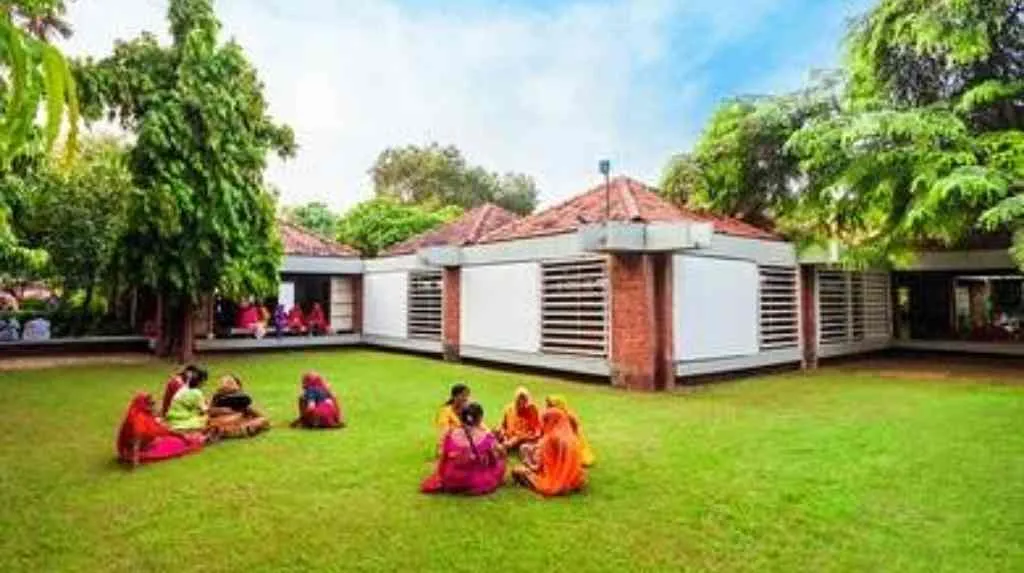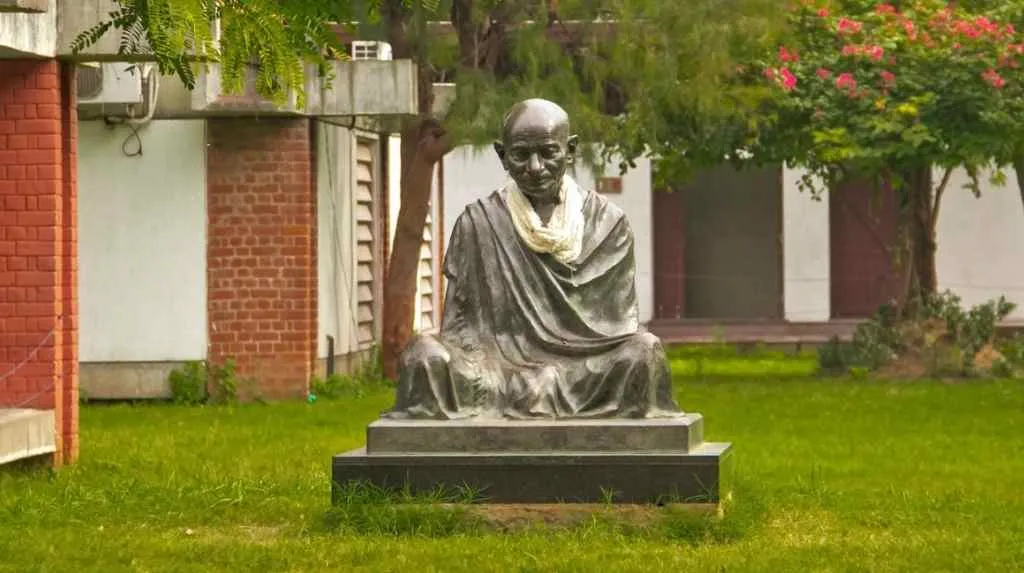Sabarmati Ashram:- During the freedom fight of India from the Britishers so many people gave their life for the country. It was not easy to unite a large number of people at the same time. So by the nation leaders few places are decided. Some leaders made their own places. The father of the nation Mahatma Gandhiji also have established such place where the freedom fighters were gathering. The place is known as ‘Sabarmati Ashram.’ Let’s see the information about it.
Sabarmati Ashram Introduction:-
Sabarmati Ashram, also known as Harijan Ashram, Gandhi Ashram or Satyagraha Ashram is located on the banks of the river Sabarmati in the city of Ahmedabad, the administrative headquarters of the Ahmedabad district in the state of Gujarat in the western part of India. Known as the camp of Satyagraha against the British, this ashram was established in AD 1917. It was done by Mahatma Gandhi in the year 1917 at Kocharab Ashram in Paldi area of Ahmedabad city.
Gandhi Ashram was Gandhiji’s pre-independence residence. From here he started the freedom movement. Gandhiji used to sit on the shore and pray to Sabarmati in the evening. Gandhiji started the Dandi March from Gandhi Ashram for the Salt Satyagraha from here only on 12th March 1930. This ashram is also known as Harijan Ashram. Even today the dignity of Gandhi Ashram is maintained and many foreigners visit the ashram. Gandhiji’s old things are also placed here.
Must Read : Swami Vivekananda Biography
Sabarmati Ashram History:-
Gandhiji’s Bharat Ashram was started on May 25, 1915 in the Kocharab bungalow of Barrister and Gandhi’s friend Jivanlal Desai. At that time the ashram was called Satyagraha Ashram. But Gandhi wanted to carry out various activities like farming and animal husbandry among other activities, which required a large area of useful land. So two years later, on 17th June 1917, the Ashram was relocated to an area of 36 acres along the Sabarmati river, and it became known as Sabarmati Ashram.
It is believed that this is one of the ancient monastery sites of Dadhichi sage who donated his bones for a just war. His main ashram is at Naimisharanya near Lucknow in Uttar Pradesh. The Sabarmati Ashram is situated between a jail and a cemetery, and Gandhi believed that a satyagrahi would have to go anywhere. Mohandas Gandhi said, “This is the right place for our activities to continue the search for truth and to develop fearlessness, because on the one hand there are the iron bars of foreigners, and on the other hand there is the hurricane of Mother Nature.”
While in the ashram, Gandhi set up a third school, focusing on manual labor, agriculture and literacy, to further his efforts for the nation’s self-reliance. From here, on March 12, 1930, Gandhi marched to Dandi, 241 miles from the ashram, with 78 allies protesting against the British salt law, which increased the tax on Indian salt in an attempt to promote the sale of British salt. India. This march and the subsequent illicit salt production that involved hundreds of thousands of people across India to illegally produce, buy or sell salt. About 60,000 people were imprisoned by the British Raj in the following three weeks for this mass civil disobedience.
The government then confiscated the ashram. Gandhi later asked the government to return it but they were not happy. He had by then decided to demolish the ashram on July 22, 1933, which had become a desolate place after many detainees. Then the locals decided to save him. On 12 March 1930, Gandhi took an oath that he would not return to the Sabarmati Ashram until India gained independence and Gandhi returned to the Sabarmati Ashram. Gandhi was assassinated on January 30, 1948 by Nathuram Godsay.
Walking tours of the Sabarmati Ashram:-
With a pre-appointment from The Secretary, Gandhi Ashram Suraksha and Smarak Trust, a walking tour can be arranged. The 90-minute guided tour begins with a slide show and ends at the library.

The tour visits the following places:-
Magan Niwas – Magan Gandhi – Displays different designs of Charkhas.
Temple of Worship – Prayer ground where the Ashram dwellers listened to hymns and recitation of Holy Gita, Quran and Bible.
Heart bow.
Vinoba-Mira cottage- hut where Vinoba Bhave and Madeleine, daughter of British Rear-Admiral Sir Edmund Slade, stayed on various occasions.
Nandini – This was the guest house of the ashram.
Udyog Mandir- Udyog Mandir which symbolizes self-reliance and pride of labor.
Somnath Chhatralaya – A set of rooms occupied by ashram schools which leave family matters and share the ashram life.
Teacher’s residence – Bapu’s associates stayed in the teachers’ room.
Gandhi in Ahmedabad – This gallery displays the major events of Gandhiji’s life in Ahmedabad from 1915 to 1930.
Painting Gallery – Eight life size paintings on display.
My life is my message – the events that were the turning point in Gandhiji’s life and that ultimately changed the history of India are illustrated by oil paintings and photographs.
Library and Archives – The archives preserve the eternal Gandhian legacy in 34,000 manuscripts, 150 honors, 6,000 photo negatives and 200 files of photostats. The library has 4,500 books from Mahadevbhai Desai’s personal collection and 35,000 books including books on Gandhian thought. It is an invaluable tool for researchers. There are also many other rare books of all religions. The opening hours of the library are from 11:00 to 18:00. Books cannot be borrowed but can be read in the library.
Sabarmati Ashram Activities:-
- About 2 lakh visitors visit Sabarmati Ashram every year. Whose needs are taken care of. The Ashram is open to visitors all year round from 8 am to 6 pm.
- Collect, process, preserve and display archives content such as texts, photos, paintings, voice-records, films and personal effects.
- The charkho used by Gandhiji for making khadi and his table on which he used to write letters are kept in mind.
- Preservation of microfilming, lamination and photo negatives.
- Arrangement of exhibitions of different parts of Gandhiji’s life, literature and activities.
- Publication of ‘Mahadevbha’s Diary’ which describes the history of Indian freedom struggle.
- The Ashram Trust provides funds for visitors and communities for activities such as education and regular maintenance of the museum and surrounding grounds as well as buildings.
- To study Gandhiji’s ideas and to be helpful in research on them. Stay in touch with those who have been helped. To publish the results of study and research with literature for the benefit of the people.
- To follow the events associated with Gandhiji’s life.
- Keep in touch with the youth and students and facilitate them to study Gandhiji’s ideas.
About the Museum:-
The ‘My Life is My Message’ gallery, which contains 8 magnificent paintings depicting historical events that took place in Gandhiji’s life and more than 50 photographs.
In the ‘Gandhi in Ahmedabad’ gallery, Gandhiji’s E.S. Life in Ahmedabad is shown from 1917-1950.
Magnificent oil painting gallery
The exhibition shows Gandhiji’s quotes, letters and other relics.
A library with about 3000 books and about 20 magazines on reading, Gandhiji’s life, work, teachings, Indian independence movement and related topics in Hindi, Gujarati and English languages.
The archives contain about 5,118 letters written by Gandhiji and found in them, original and photocopies, about 21 manuscripts of Gandhiji’s articles published in Harijan, Harijansevak and Harijanbandhu, and about 6,000 photos of Jachala Gandhiji and his associates.
An important landmark of the ashram is Gandhiji’s cottage ‘Hridayakunj’ in which Gandhiji’s personal relics are displayed.
The Ashram Book Store sells literature and memorabilia related to Gandhiji and his life’s work at a non-profit rate that helps local artisans.
How to reach Sabarmati Ashram:-
By plane:-
Ahmedabad’s Sardar Vallabhbhai Patel Airport is an international airport with direct flights to USA, UK, Singapore, Dubai and other international hubs. There are also many domestic flights from here.
By train:-
The main railway station is located in Kalupur area. The station falls under the leading National Railway Circuit and is connected to all the major cities of India. If you are on the west side of Sabarmati river, you can easily go to Gandhigrim station near Ashram road to buy your train ticket.
By road:-
Gujarat has one of the most developed road network in India. Ahmedabad is well connected by road to all major cities and towns. Well known bus stops are located at Kalupur Railway Station and Gita Mandir near Paldi. Regular bus services are available from Gujarat State Transport Buses and private operators to all major destinations in the state.
Written by:- Mrs. Snehal Rajan Jani.
